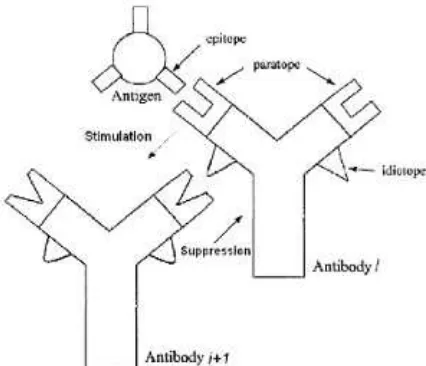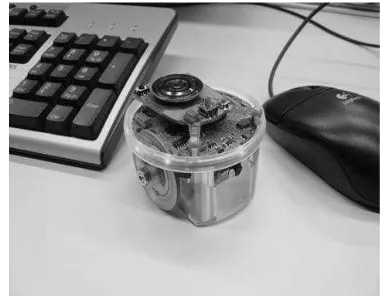Shepherding: An Immune-Inspired Robotics Approach
Sazalinsyah Razali1,2, Qinggang Meng2 & Shuang-Hua Yang2
1Faculty of Information & Communication Technology, University Teknikal Malaysia Melaka, 76109
Durian Tunggal, Melaka, Malaysia (E-mail: [email protected])
2Department of Computer Science, Loughborough University, LE11 4PG, Loughborough, U.K.
(E-mail: {S.Razali | Q.Meng | S.H.Yang}@lboro.ac.uk)
Keywords: artificial immune systems, multi-robot systems, cooperation, shepherding
Abstract: In this research, basic biological immune systems and their responses to external elements to maintain an organism’s health state are used as an inspiration for solving a specific multi-robot system problem. The proposed algorithm is based on immune network theories that have many similarities with the multi-robot systems domain. The approach uses a memory-based immune network that enhances a robot’s action-selection process and can obtain an overall a quick group response. The algorithm is applied on the Player/Stage simulation platform and evaluated using the sheepdog scenario. The project proceeds to investigate the low-level shepherding behaviour, specifically the shepherds' Line Formation.
One of the main issues being studied in Multi-Robot System is cooperation between mobile and autonomous robots in order to achieve a common goal or to maximize the utility for each agent. Robots can also be viewed as agents, specifically embodied agents situated in the physical world. Effective cooperation entails that the total utility of the system is increased, but at the same time the goal of each single agent is not totally abandoned or delayed for too long.
The problem this research is trying to address is the use of an effective algorithm for cooperation of different robots in a team to achieve its design objectives. This problem has indeed been studied by many researchers either in the robotics area or in the Multi-Agent Systems area. However, few of these studies are looking at biologically-inspired algorithms in approaching the problem. Little research is done in utilizing the Immune Systems as a metaphor for cooperation in the robot/agent teams.
Biological immune systems are evident in the emergent cooperative behaviour of the virus-fighting cells in the body. Therefore, the overall aim of this study is the use of immunology-based algorithm in achieving adaptive cooperation in a group of heterogeneous robots. Furthermore, interactions between heterogeneous robots
in relevant scenarios are also investigated because of its wide applicability in the real world.
Immune system is a system that eliminates foreign substances from an organism’s body. These foreign substances such as bacteria, fungi or virus cells that can harm the host are called pathogens. When such substance activates an immune response it is called antigen, which stimulates the system’s antibody generation. Each antigen has a unique set of identification on its surface called epitope. These antigenic determinants are where the host’s antibodies would attach to by using their paratope, as shown in Figure 1. Antibodies are cells in the immune system that kill antigens in order to maintain the host homeostatic state—i.e. balancing the body’s health status.
Studies in immunology have suggested that antibodies are not isolated but they ‘communicate’ with each other. Each type of antibody has its specific idiotope, an antigen determinant as shown in Figure 1. Jerne (1984) had proposed the Idiotypic Network Hypothesis (also known as Idiotypic Network Theory) which views the immune system as a large-scale closed system consisting of interaction of various lymphocytes (i.e. B-cells).
i+1. These mutual stimulation and suppression chains between antibodies form a controlling mechanism for the immune response.
Figure 1. Antigen-antibody binding and Jerne’s Idiotypic Network Theory
The relationship of immune systems with multi-robot systems is evident where obstacles, robots and their responses are antigens, B-cells and antibodies respectively. Table 1 lists the obvious parallel of multi-robot systems and immune systems terminologies.
Table 1. Immune systems and multi-robot systems relationship
In this research we investigate shepherding behaviour of robots. Shepherding behaviour is similar to a flocking behaviour but having agents/robots outside of the flock guiding or controlling the members (Lien et al. 2004).
This problem is highly dynamic and obviously requires the robots to have real-time processing of partial information of the environment.
Our proposed algorithm is based on immune network theories that have many similarities with the multi-robot systems domain. The research proposes a memory-based immune network that enhances a robot's action-selection process and can obtain an overall a quick group response. The algorithm which is named as Immune Network T-cell-regulated—with Memory (INT-M) is applied to the sheepdog scenario (Razali et al. 2009).
Figure 2. The INT-M states, the greyed states are bypassed when the memory mechanism is triggered resulting in the dashed arrow lines
The INT-M model is based upon the work by Sun et al. (2001), and it involves modelling the memory part of the biological immune systems. A specific memory mechanism is proposed in order to retain the appropriate action for relevant environment condition. This mechanism is introduced when the newly sensed environment is similar to the previous environment. Thus, a quick action-selection process can be executed without the need of re-evaluating the new situation, as shown in Figure 2.
The robot dogs use the proposed immune inspired approach in cooperating with one another while the robot sheep have basic avoidance and wandering behaviours. In a sheepdog problem, a few dogs try to guide a few sheep to the grazing site (also called the safety zone) without going beyond the borders (Schultz et al. 1996). The objective is to herd the sheep into the grazing site while having partial information of what is happening in the area. Simulation experiments were conducted on the Player/Stage robotics platform (Gerkey et al. 2003).
Figure 3. Snapshot of the sheepdog simulation scenario showing a group of robot dogs cooperatively herding a group of robot sheep into the central grazing site
Figure 4. A snapshot of low-level behaviour of shepherd formation – forming a straight line behind a single static sheep
The research proceeds by investigating better shepherds' low-level behaviour and a specific shepherd formation known as Line Formation (Lien et al. 2005) is selected, as shown in Figure 4. The simulation scenario of herding is chosen whereby the dogs will herd the sheep
from a start location (bottom left in Figure 4) towards the central grazing site.
In this research project, a memory-based immune-inspired approach for cooperation in multi-robot systems domain has been proposed and applied to the sheepdog test scenario. Basic concepts and mechanisms of biological immune systems have been described and the immune network is argued as a suitable analogy for multi-robot cooperation problem. A simulation environment has been set-up to evaluate the proposed approach and algorithm.
The project proceeds by investigating into shepherds formation in order to have better group shepherding behaviour. Furthermore, the herding behaviour is selected as a group task in the test scenario. The proposed model will also be implemented in real robots and for this purpose a group of e-puck mobile robots (Mondada et al. 2009) as shown in Figure 5 will be used.
Figure 5. An example of the e-puck mobile robot that will be used in the research (Mondada et al. 2009)
The proposed approach can also be extended to other application domains which require several distributed agents (robots) to work cooperatively in a dynamic environment.
Mr. Razali gratefully acknowledges Malaysian Ministry of Higher Education and Universiti Teknikal Malaysia Melaka (UTeM) for sponsoring his PhD study.
Gerkey, B., Vaughan, R. T. & Howard, A. 2003. The player/stage project: Tools for multi-robot and distributed sensor systems. Proceedings of the 11th International Conference on Advanced Robotics, pp. 317–323.
Jerne, N. K. 1984. Idiotypic networks and other preconceived ideas. Immunological Reviews, Vol. 79, No. 1, pp. 5–24.
Proceedings of the 2004 IEEE International Conference on Robotics and Automation, Vol. 4, pp. 4159–4164.
Lien, J. M., Rodriguez, S., Malric, J. & Amato, N. M. 2005. Shepherding behaviors with multiple shepherds. Proceedings of the 2005 IEEE International Conference on Robotics and Automation, pp. 3402–3407.
Mondada, F., Bonani, M., Raemy, X., Pugh, J., Cianci, C., Klaptocz, A., Magnenat, S., Zufferey, J. C., Floreano, D. & Martinoli, A. 2009. The e-puck, a robot designed for education in engineering.
Proceedings of the 9th Conference on Autonomous Robot Systems and Competitions, Vol. 1, No. 1, pp. 59–65.
Razali, S., Meng, Q. & Yang, S. H. 2009. Multi-robot cooperation using immune network with memory.
Proceedings of the 7th IEEE International Conference on Control and Automation, pp. 145– 150.
Schultz, A., Grefenstette, J. J. & Adams, W. 1996. Roboshepherd: Learning a complex behavior.
Robotics and Manufacturing: Recent Trends in Research and Applications, Vol. 6, pp. 763–768. Sun, S. J., Lee, D. W. & Sim, K. B. 2001. Artificial

